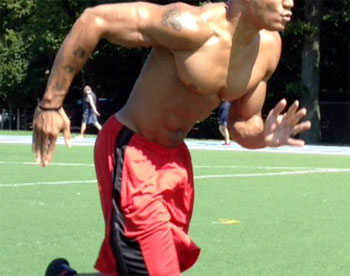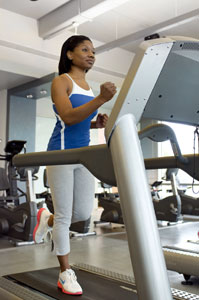Should I Do Slow or Fast Cardio for The Best Fat Loss Results?
![]() I just got back into the gym and I really like to use the elliptical trainer. I do it for about 1 hour per day and I’ve been losing about 1 pound of fat per week. I find that going slower with higher resistance burns up to 250 more calories per hour than going faster with less resistance. It seems logical that the higher calorie burn method would yield faster weight loss results. Which of these methods (slow versus fast) is truly better for overall fat burning and weight loss?
I just got back into the gym and I really like to use the elliptical trainer. I do it for about 1 hour per day and I’ve been losing about 1 pound of fat per week. I find that going slower with higher resistance burns up to 250 more calories per hour than going faster with less resistance. It seems logical that the higher calorie burn method would yield faster weight loss results. Which of these methods (slow versus fast) is truly better for overall fat burning and weight loss?
![]() If you’re looking to lose weight then you’ve probably realized that there are many different forms of cardio, each presenting their own benefits. But which one is the best for you? Many factors would have to be taken into account in order to answer that question. However, the two most popular forms of cardio are LISS and HIIT, so we will review these two forms and come to a conclusion of which would be the best for your particular situation.
If you’re looking to lose weight then you’ve probably realized that there are many different forms of cardio, each presenting their own benefits. But which one is the best for you? Many factors would have to be taken into account in order to answer that question. However, the two most popular forms of cardio are LISS and HIIT, so we will review these two forms and come to a conclusion of which would be the best for your particular situation.
What exactly is LISS and HIIT? These are acronyms; LISS stands for Low Intensity Steady State and HIIT stands for High Intensity Interval Training. In basic terms, LISS is the cardio that we’re all familiar with, such as walking on the treadmill for 30 minutes or riding the stationary bike for an hour at pretty much the same speed and intensity (hence the term “steady state”). HIIT is a lesser-known form of cardio but it’s extremely effective. It involves switching up the intensity of your cardio workout. So for example, you might sprint for 60 seconds as fast as you can and then walk for 60 seconds at a slower pace. You can also do this type of HIIT workout with your elliptical machine. Just make sure to go all out on the intense interval session and don’t let up!
High intensity interval training supercharges your metabolism and burns lots of calories in a short amount of time. With a HIIT routine, you will basically work in intervals of intensity through your workout. Another example is using the stationary bike. You will warm up for 2 minutes at about a 50% exertion rate. Then, for the next 60 seconds you will go all out as fast as you can go at about a 90-95% exertion rate. Then, cool down for 30 seconds at about 50-60% and do it all over again. Do this for the next 15-20 minutes and then finally cool down for the last 2 minutes at 50% exertion. Trust me, you will be absolutely burnt out at the end and will be screaming to get off the bike. This is a good thing!

So now that you know a little bit more about these two common forms of cardio, we’ll get into the advantages and disadvantages of each one.
Low Intensity Steady State (LISS)
- A better solution for those who want to relax during their cardio session and “take it easy”.
- Could quickly become boring for some people.
- Much easier on your bones and joints, so probably a better choice for the older individual.
- Requires longer time to complete the workout which is not ideal for busy people who don’t have a lot of time for cardio.
- Doesn’t provide results as fast as HIIT.
- Easier to keep track of your workout and set goals for next time.
- Ability to talk with friends during your cardio session.
High Intensity Interval Training (HIIT)
- Requires very little time to get a high calorie burning workout (15-20 minutes) which is great for people with busy schedules.
- Requires more focus as you have to keep track of timing.
- Better results than LISS (a nine-fold expansion in weight loss has been reported from a 1994 study).
- Tougher on your joints as your sessions are much more intense.
- Might not be the best choice if you’re a beginner and not familiar with cardio.
- Harder to keep a record of your workout.
- Must concentrate on the workout, no time to socialize.
- A better solution for the more serious fitness enthusiast, may be too “hardcore” for the casual gym-goer.
As you can see, there are many advantages as well as disadvantages to both forms of cardio. While high intensity interval training has been proven to be more effective and promote nine-fold results for weight loss, it is also a much more difficult workout and harder to keep track of. For these reasons alone, I would see HIIT as a cardio workout suited more towards the serious fitness enthusiast. A casual lifter might benefit more doing standard steady state cardio. So the debate of slow cardio versus fast cardio for fat loss really comes down to your individual goals and how much you are dedicated to health and fitness.
Also keep in mind that if you are inexperienced or elderly, it’s probably best to stay away from HIIT as it requires a lot of concentration and monitoring. You will still achieve great results with steady state cardio and it will be a lot more fun.
To answer your specific question, the simple fact is that the more calories you burn per session, the more body weight you will lose. So, by going slower with higher resistance, this will be the ideal way to drop weight since you’re burning 250 more calories per hour. It might also be great to incorporate both styles of training into your cardio routine so you can mix it up and see which one works best for you!
-
Is HIIT High Intensity Cardio Effective for Burning Fat?
I have read about this High Intensity Interval Trainin
-
How do you lose fat from your stomach thighs and love handles without looking muscular?
How do you lose fat from your stomach thighs and love handles with
-
If you are running and doing weights is it better to run first and then do weights to develop muscle or visa versa?
If you are running and doing weights is it better to run first and
-
Does shape wear help lose weight?
Does shape wear help lose weight? No it doesnt h
-
How Can I Build Up My Inner Chest Muscles?
How can I build up the middle and inner part of my che
-
How much should a 5 month old Doberman weigh?
How much should a 5 month old Doberman weigh? 45
- DON'T MISS
- What are The Best Weight Lifting Supplements To Get Big?
- What are Some Good Chest Workouts for Women?
- How Much Cardio Exercise Should I Do To Lose Weight?
- How Can I Workout When I Work a Late Night Shift?
- How many grams of fat should you eat if you are looking to lose weight?
- What are The Best Exercises To Burn Lots of Body Fat?
- How do you get rid of a double chin?
- Why Can’t I Lose Weight Despite Tons of Exercise?
- How can you get rid of or tone the fat in your arms?
- Why Do I Have Asymmetrical Abdominal Development?




